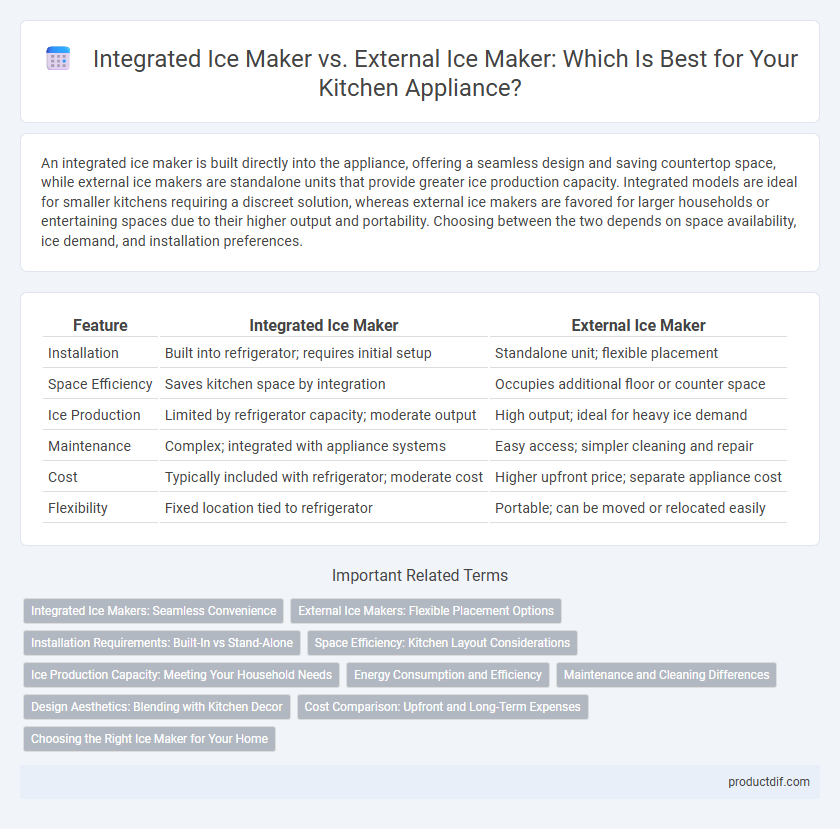An integrated ice maker is built directly into the appliance, offering a seamless design and saving countertop space, while external ice makers are standalone units that provide greater ice production capacity. Integrated models are ideal for smaller kitchens requiring a discreet solution, whereas external ice makers are favored for larger households or entertaining spaces due to their higher output and portability. Choosing between the two depends on space availability, ice demand, and installation preferences.
Table of Comparison
| Feature | Integrated Ice Maker | External Ice Maker |
|---|---|---|
| Installation | Built into refrigerator; requires initial setup | Standalone unit; flexible placement |
| Space Efficiency | Saves kitchen space by integration | Occupies additional floor or counter space |
| Ice Production | Limited by refrigerator capacity; moderate output | High output; ideal for heavy ice demand |
| Maintenance | Complex; integrated with appliance systems | Easy access; simpler cleaning and repair |
| Cost | Typically included with refrigerator; moderate cost | Higher upfront price; separate appliance cost |
| Flexibility | Fixed location tied to refrigerator | Portable; can be moved or relocated easily |
Integrated Ice Makers: Seamless Convenience
Integrated ice makers offer seamless convenience by being built directly into refrigerators, saving valuable kitchen space and eliminating the need for additional units. These devices provide a steady supply of ice without the hassle of refilling trays, featuring advanced filtration systems that ensure clean, fresh-tasting ice. With smart technology integration, users can control ice production and monitor usage through connected apps, enhancing overall kitchen efficiency.
External Ice Makers: Flexible Placement Options
External ice makers offer flexible placement options, allowing installation in various locations such as countertops, under cabinets, or in bars without the need for built-in space. These appliances typically require only a water connection and power outlet, making them suitable for kitchens with limited space or open layouts. Their portability and versatility make external ice makers an ideal choice for both residential and commercial settings seeking convenience and efficiency.
Installation Requirements: Built-In vs Stand-Alone
Integrated ice makers require built-in installation within the refrigerator unit, optimizing kitchen space and maintaining a seamless appliance design. External ice makers function as stand-alone units and need dedicated countertop or floor space, along with separate water line connections for proper operation. Choosing between these depends on kitchen layout, available space, and whether a flush aesthetic or independent mobility is preferred.
Space Efficiency: Kitchen Layout Considerations
Integrated ice makers optimize space by being built directly into refrigerators or freezers, freeing up kitchen floor area and maintaining a streamlined look. External ice makers require additional countertop or floor space, which can clutter the kitchen and limit layout flexibility. Choosing between integrated and external models depends on available kitchen space and the balance between appliance capacity and room for other essential functions.
Ice Production Capacity: Meeting Your Household Needs
An integrated ice maker typically produces between 20 to 40 pounds of ice per day, suitable for small to medium households. External ice makers can generate up to 50 pounds or more daily, ideal for larger families or frequent entertaining. Choosing between these depends on your household's typical ice consumption and available space.
Energy Consumption and Efficiency
Integrated ice makers typically consume less energy as they use the appliance's existing cooling system, eliminating the need for additional power sources. External ice makers, while often faster at producing large ice volumes, require separate power supplies which can increase overall energy consumption. Efficiency in integrated models comes from seamless operation within the appliance, reducing energy waste compared to standalone external units.
Maintenance and Cleaning Differences
Integrated ice makers require less frequent maintenance because they are designed to work seamlessly within the appliance's filtration and drainage systems, reducing buildup and contamination risks. External ice makers need more regular cleaning and maintenance since they are exposed to external contaminants and often require manual water refills, increasing the likelihood of mineral deposits and mold growth. Proper maintenance of integrated units typically involves periodic filter replacement, while external units demand thorough cleaning of water lines and ice trays to prevent bacterial growth.
Design Aesthetics: Blending with Kitchen Decor
Integrated ice makers seamlessly blend into kitchen cabinetry, offering a sleek, minimalist look that enhances overall design aesthetics. External ice makers often stand out as separate appliances, potentially disrupting the visual harmony of a countertop or kitchen layout. Choosing an integrated ice maker supports a cohesive and modern kitchen decor, while external units provide flexibility but may compromise design uniformity.
Cost Comparison: Upfront and Long-Term Expenses
Integrated ice makers typically have a higher upfront cost due to complex installation and built-in design but offer lower long-term expenses through energy efficiency and reduced maintenance. External ice makers require a lower initial investment and easier installation, though they may incur higher operating costs and more frequent repairs over time. Evaluating total cost of ownership, including energy consumption and service needs, reveals integrated units as more cost-effective for long-term use despite greater initial spending.
Choosing the Right Ice Maker for Your Home
Integrated ice makers offer seamless installation within your existing refrigerator, maximizing kitchen space and maintaining a clean aesthetic, while external ice makers provide higher ice production capacity and flexibility to place the unit anywhere. Choosing the right ice maker depends on your household's ice consumption, available kitchen space, and preferences for installation convenience versus output volume. For smaller families or those prioritizing design, integrated models excel, whereas larger households or frequent entertainers benefit from the robust output of external ice makers.
Integrated Ice Maker vs External Ice Maker Infographic

 productdif.com
productdif.com